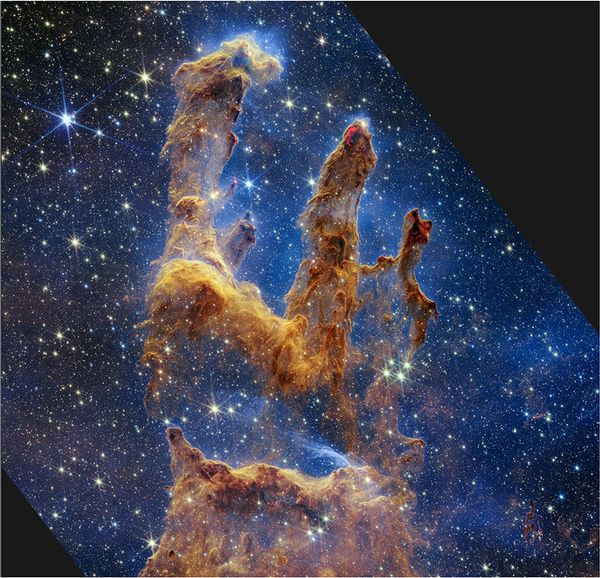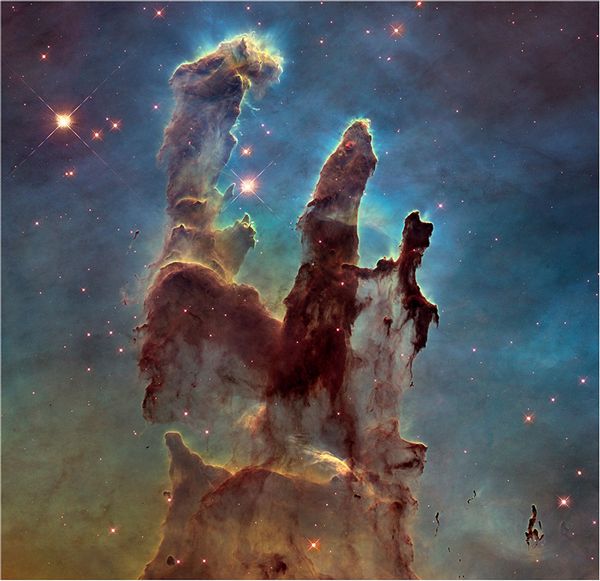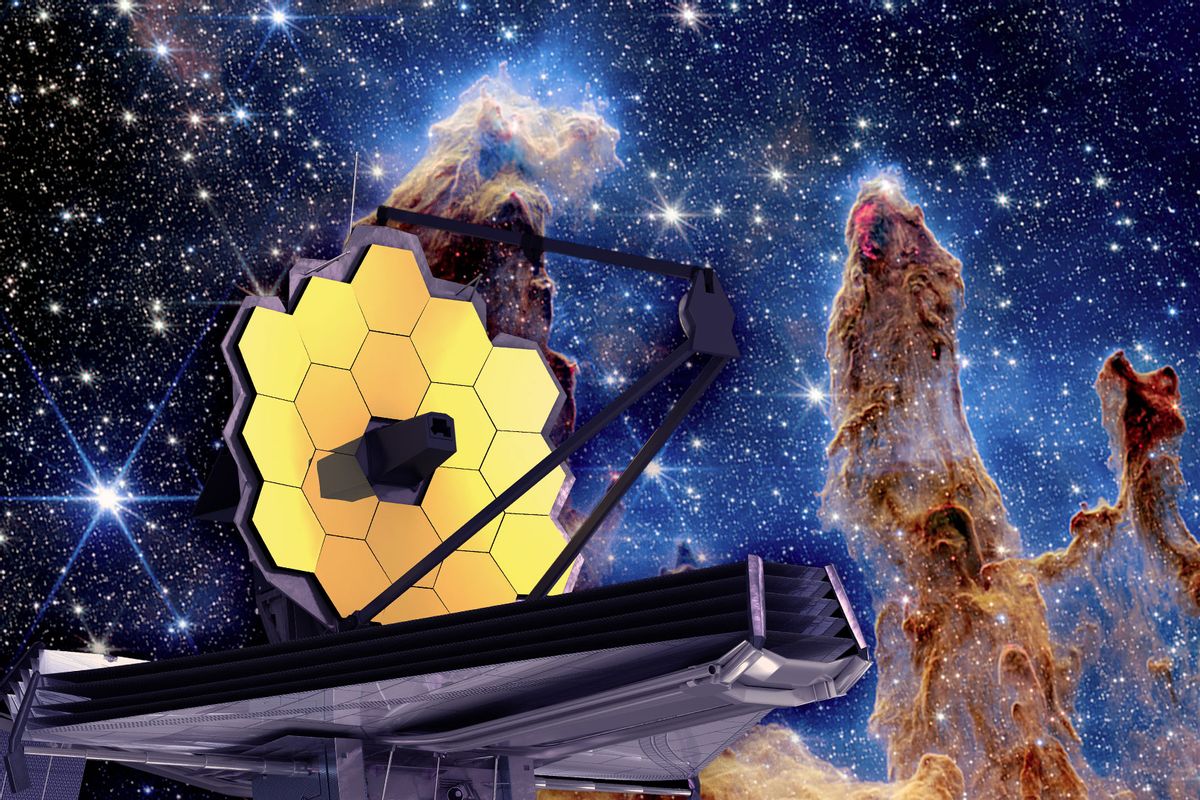Since the initial images from the James Webb Space Telescope (JWST) were unveiled in July, it has continued to produce historic images of the universe with impressive clarity. These have included a detailed view of Jupiter's atmosphere; water vapor detected on a distant planet where it was previously not known to exist; and grains of silicate like those used to make glass in the atmosphere of brown drawf VHS 1256 b, thereby solving a longstanding mystery about why it has a red glow.
Now, a new JWST image has been presented to the public — this time an unprecedented glimpse into the Pillars of Creation.
Located in the Eagle Nebula, which is part of the constellation Serpens, the Pillars of Creation are famous due to an iconic 1995 photograph shot by one of JSWT's predecessors, the Hubble Space Telescope. From a distance, that image resembles a three-fingered hand with the base of the thumb missing and countless small fingers protruding from between the main fingers and all over the palms. It is made of red, orange and yellow gases. The hand seems to grasp at a handful of shiny red stars against the blue-green vacuum of space.
 The James Webb Space Telescope's 2022 image of the Pillars of Creation (NASA, ESA, CSA, STScI)The Pillars of Creation are technically a view of a nebula, the tendrils being protostars, or stars that are in the process of forming as gas collects in their vicinity. Nebulae are sometimes called "stellar nurseries," as they are the basins in which new solar systems slowly form. Earth's solar system, including the sun, began life as a gaseous nebula before coalescing into the sparse yet distinct objects that make it up currently. The Eagle Nebula is situated 6500 light-years from Earth; for context, the Milky Way is believed to be about 105,700 light-years across, and the universe itself has a diameter of 93 billion light-years.
The James Webb Space Telescope's 2022 image of the Pillars of Creation (NASA, ESA, CSA, STScI)The Pillars of Creation are technically a view of a nebula, the tendrils being protostars, or stars that are in the process of forming as gas collects in their vicinity. Nebulae are sometimes called "stellar nurseries," as they are the basins in which new solar systems slowly form. Earth's solar system, including the sun, began life as a gaseous nebula before coalescing into the sparse yet distinct objects that make it up currently. The Eagle Nebula is situated 6500 light-years from Earth; for context, the Milky Way is believed to be about 105,700 light-years across, and the universe itself has a diameter of 93 billion light-years.
As the Biblical-sounding name suggests, the Pillars of Creation has been regularly used to evoke a sense of wonder, and has remained one of Hubble's most ubiquitous images.
The JWST image may supplant it, however. The tiny and shiny red specks from the 1995 image, resembling little more than a cluster of lanternflies, have been replaced with hundreds of yellow, blue and white dots of all sizes and levels of brightness. The background is dark blue and black, more similar to what one would expect to see while gazing at a night's sky. Yet the Pillars of Creation themselves have undergone the most remarkable transformation. The puffy texture of the 1995 image has now been replaced with a grainy one, and the brighter color scheme accentuates the yellows. The reason has to do with the observational instruments on the JWST, as it can observe different wavelengths than the Hubble Space Telescope, and also see in greater resolution. This new image was taken in the near-infrared part of the electromagnetic spectrum, in which the nebular gas and dust is more transparent than in the visible spectrum.
Compare the new JWST photo, above, with a old Hubble image from 2014:
 The Hubble Space Telescope's 2014 image of the Pillars of Creation (NASA, ESA, CSA, STScI)"The pillars look like arches and spires rising out of a desert landscape, but are filled with semi-transparent gas and dust, and ever changing," NASA explains on its website.
The Hubble Space Telescope's 2014 image of the Pillars of Creation (NASA, ESA, CSA, STScI)"The pillars look like arches and spires rising out of a desert landscape, but are filled with semi-transparent gas and dust, and ever changing," NASA explains on its website.
The JWST image of the Pillars of Creation may capture its majesty, but it perhaps does not do justice to the scale: For instance, even the tiniest mutated sub-fingers in the Pillars of Creation is larger than our entire solar system. The pillar on the far left, by contrast, is over four light-years long. This means that someone traveling at the speed of light would need four years to go from one end to the other, as the actual distance is roughly 25 trillion miles (or 40 trillion kilometers). This is why subsequent telescopic observations have repeatedly yielded new details about the celestial feature. The ESA's Herschel Space Observatory used far-infrared wavelengths in 2010 to learn more about the structures inside each of those fingers, and future Hubble images would reveal even more details.
Want more health and science stories in your inbox? Subscribe to Salon's weekly newsletter The Vulgar Scientist.
"Webb's new view of the Pillars of Creation, which were first made famous when imaged by NASA's Hubble Space Telescope in 1995, will help researchers revamp their models of star formation by identifying far more precise counts of newly formed stars, along with the quantities of gas and dust in the region," NASA said in a statement. "Over time, they will begin to build a clearer understanding of how stars form and burst out of these dusty clouds over millions of years."



Shares